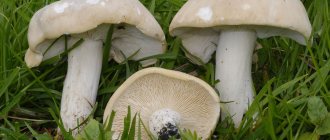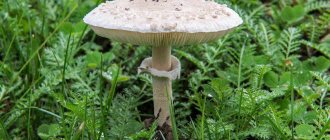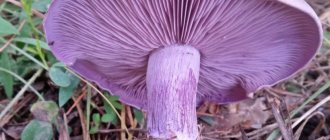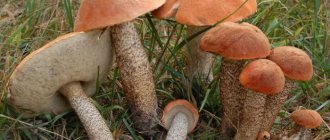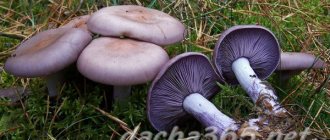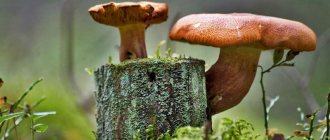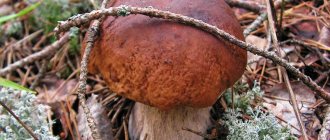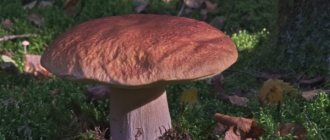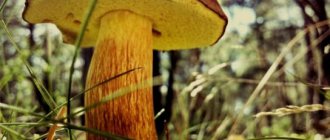Ryadovka (tricholoma) is a mushroom that can be either edible or poisonous. Row mushrooms belong to the department Basidiomycetes, class Agaricomycetes, order Agariaceae, family Rowaceae, genus Row. Often the name “Ryadovka” is applied to other mushrooms from the family of Ryadovka and other families.
Row mushrooms got their name due to their ability to grow in large colonies arranged in long rows and witch circles.
Photo by: Anna Baykalova
Row: description of the mushroom, characteristics, photo. What does the row look like?
hat
The fruiting bodies of mushrooms have a cap-peduncle structure and are characterized by significant variability in external characteristics. The cap of a young row, depending on the type, can be spherical, cone-shaped or bell-shaped. The diameter of the cap varies from 3 to 20 cm in different species. With age, the caps straighten and become flat-spread; in many species, a well-defined tubercle remains in the center. The edges of the cap can be smooth, wavy, sometimes tucked or, conversely, bent outward.
The skin of the row cap can be dry and velvety, fibrous, scaly or completely smooth and slimy. The color of the cap depends on the species and can be pure white or represent various variations of yellow, green, red and brown. As the mushroom grows, the color of the cap may undergo significant changes.
Author of the photo: Vyacheslav Stepanov
Hymenophore
Under the cap, row mushrooms have plates that are covered with a spore-bearing layer - the hymenium. The plates of some species are thin and frequent, while in others they are sparse and fleshy, thoroughly fused with the stalk. In young mushrooms, the hymenophore is white and smooth; with age, its surface turns brown, becomes covered with brown spots, and the edges become uneven or torn.
Photo by: James Lindsey
Leg
The average height of the row leg varies from 3 to 10 cm, thickness - from 0.7 to 2 cm. The shape of the leg can be straight cylindrical, club-shaped or expanding towards the top or bottom. The leg can be completely bare, velvety, fibrous or covered with scales.
The main color of the leg is pinkish-brown, and under the cap there may be a sharply limited or blurred white zone. In some species, the color of the stem may be purple, and under the cap there may be a fibrous ring - the remains of a protective covering.
Author of the photo: Tatyana Svetlova
Spores and spore powder
The row mushroom has oblong, smooth, white or colorless spores. Spore powder is often white, sometimes brown.
Dangerous false doubles
Poisonous greenfinch imitator:
- Sulfur row (Latin name: Tricholoma sulphureum) - has a smaller size, bright sulfur-lemon color, yellow flesh, bitter taste and bad odor. Grows in coniferous and deciduous groves in July–October. Sulfur row
Inedible lookalikes:
- Separated row (lat. Tricholoma sejunctum) - it has rarer plates than the golden row, yellowish or white. The pulp is bitter. Separate row
- Sultry row (lat.Tricholoma aestuans) is a smaller fruit with a bad smell and taste.
The row is sultry
Podzelenka is also similar to some of its brethren, ranging from mildly poisonous to edible. This:
- Pointed row (lat. Tricholoma virgatum) is a poisonous mushroom with a thinner, ash-colored cap with a mound in the center. The plates are grayish in tone. The pulp is hot to taste.
- Soap row (lat. Tricholoma saponaceum) is an inedible species. It has a more uniform color and no fibrousness. Smells strongly of laundry soap.
- The different row (lat. Tricholoma sejunctum) is conditionally edible. The leg can be white, chestnut, green. The pulp has a bad smell.
- Tricholoma terreum (lat. Tricholoma terreum) is an edible species. Significantly smaller in size. The surface of the cap is fibrous and scaly. The plates are rarer, steel-colored.
Where do rowads (tricholomas) grow?
Rowers are ground mushrooms that are distributed throughout the temperate zone of the Northern Hemisphere. Most species are mycorrhiza-formers, and as mycorrhizal partners they prefer coniferous trees: more often pine, less often larch, spruce and fir; rare species are in symbiosis with oak, birch and beech.
Rows grow on poor sandy or calcareous soils of coniferous and mixed forests. They usually appear in late summer and bear fruit until frost. But there are also species that can be collected in the spring.
Mushrooms grow singly, in small or large groups, forming long rows or ring colonies - “witch circles”.
Photo credit: Ruesterstaude
Cooking recipes
The option for processing greens and lemon rows depends on the taste of the housewife. They go well with meat dishes and are appropriate in soups and sauces. They can be boiled, fried, pickled, dried. Both young and adult specimens are used.
Preliminary processing
First of all, you need to remove the skin from the caps, peel the fruits, rinse them in running water, removing all contaminants. Pay special attention to the leg, which can be deeply immersed in the soil and stained with sand.
Afterwards, it is advisable to soak the mushrooms for 2 hours in warm salted water to complete the cleansing process. Then carry out heat treatment. You can’t eat fresh greens and jaundice.
How long to cook rows?
Mushrooms are filled with water and placed on fire. When boiling, add some salt, cooking lasts about 20 minutes - taking into account the age of the fruit. Then drain the liquid and spray the rows with a stream of cold water.
Frying
With this method of cooking, the dishes are aromatic. The following ingredients are taken:
- boiled fruits - 500 grams;
- onion - 1 piece;
- sour cream - 4 tbsp. l.;
- salt, pepper - to taste.
Prepare like this:
- Cut the cooled rows into pieces.
- Fry the onion in vegetable oil until amber in color.
- Place the greens in the pan and fry for 10–15 minutes.
- Add 4 tbsp. l. sour cream, simmer over low heat for a quarter of an hour.
- Salt and pepper are added to taste.
Serve preferably with potatoes.
Cold salting at home
To do this you need to take the ingredients:
- pine trees - 1 kg;
- salt - 50 g;
- cherry, horseradish, currant leaves;
- dill - 2-3 sprigs;
- garlic - 3 cloves;
- peppercorns - 10 pieces:
- several laurel leaves;
- salt - for filling the container.
Horseradish prevents the product from souring and adds pungency, while dill and currants add aroma. The cherry leaves make the mushrooms supple and crunchy.
Process:
- Cover the bottom of the vessel with a thin layer of salt. Cover the top with currant, cherry, horseradish, and dill leaves.
- Place one layer of pine trees, caps down, no more than 6 cm thick, on top of the herbs. Cover with salt again, add pepper, garlic, and add bay leaf.
- We repeat the phase and continue in the same order until we put everything in place. Add the last layer of leaves, spices, garlic, and salt. We lay a cloth napkin on top, press it with a wooden circle, and apply moderate pressure.
- After a couple of days, juice will begin to release, the product will settle and be covered with brine. The load needs to be heavier. When mold appears, the circle and bend are washed, and the fabric is replaced with a clean one.
The ripening time for rows is 1–1.5 months. The container must be kept in a cool place.
The method ensures good storage of fruits; they become crispy, hard, and emit a wonderful mushroom smell.
How to roll up autumn mushrooms for the winter?
Greens and greens are salted for the winter according to the following recipe.
Ingredients:
- mushrooms - 1 kg;
- black currant leaf - 2 pcs.;
- cherry leaf - 2 pcs.;
- dill seed - 30 gr.;
- bay leaf - 3 pcs.;
- black pepper - 6 peas;
- sugar - 2.5 tbsp. l.;
- salt - 1.5 tbsp. l.;
- mustard - 15 g.
Prepare like this:
- Place the cooled rows tightly in jars, interspersed with cherry, currant and bay leaves.
- Make a brine using 1 liter of water, salt, sugar, pepper. Pour dry mustard into the already boiling liquid, stir and wait 10 minutes.
- Fill the jars with the product with brine, roll up the lids, and place in a cool place.
You can eat mushrooms within a week and throughout the winter.
Pickling
For this method, you should prepare a pickle using:
- water - 1 l.;
- salt - 1.5 tbsp. l.;
- allspice - 6 peas;
- clove - bud;
- vinegar - 1 tsp.
Place the boiled mushrooms in containers and pour hot sauce over them, add vinegar essence. Cover with plastic lids. Pickled greens and greens have a pleasant taste and aroma.
Row mushrooms: photos, types, names
The genus Ryadovka includes about 100 species of mushrooms, 45 of which grow in Russia. Below are the types of rows (from the row family and other families) with descriptions and photographs.
Edible rows, photo and description
- Gray rower (hatched rower, pine pine, silver grass, green grass, gray sandpiper) (Tricholoma portentosum)
This is an edible mushroom. Common names: little mice, little mouse, little mouse. The fleshy cap of the serushka, with a diameter of 4 to 12 cm, is initially round, but over time it becomes flat and uneven, with a flattened tubercle in the middle. The smooth skin of old mushrooms cracks, and its color is mousey or dark gray, sometimes with a greenish or purple tint. The smooth leg has a height of 4 to 15 cm, wider at the base, covered with a powdery coating at the top, and becomes hollow over time. The color of the leg is whitish with a gray-yellow tint. The blades of this type of row are wide, sparse, initially white, and eventually turn yellow or gray. The dense whitish pulp of the serushka often turns yellow at the break and has a characteristic, weakly expressed, mealy taste and weak aroma.
The gray row mushroom is a mycorrhizal partner of pine, therefore it grows mainly in pine forests throughout the temperate zone, often adjacent to greenfinch. It appears in September and leaves only at the end of autumn (November).
Photo by: Aorg1961
Photo by: Dan Molter (shroomydan)
- Lilac-legged row (blue-legged, blue root, two-color row, purple-legged lepista) (Lepista personata, Lepista saeva)
An edible mushroom from the genus Lepista, family Ryadomaceae. This row can be distinguished by the purple color of the legs. The cap has a diameter of 6-15 cm (sometimes up to 25 cm) and a smooth yellowish-beige surface with a purple tint. The plates of the mushroom are frequent, wide, yellowish or cream-colored. The stalk is 5-10 cm high and up to 3 cm thick. In young rows, a fibrous ring is clearly visible on the stalk. The fleshy pulp of two-color rows can be white, grayish or gray-violet with a mild sweetish taste and a light aroma of fruit.
Lilac-legged row mushrooms grow mainly in deciduous forests of the temperate zone with a predominance of ash. They are found throughout Russia. They bear fruit in large families, in a fruitful year - from mid-spring (April) until persistent frosts (November).
Photo credit: Strobilomyces
Photo by: Paffka
- Earthy row (earth-gray row, ground row) (Tricholoma terreum)
Edible mushroom. In young mushrooms, the cap with a diameter of 3-9 cm has the shape of a cone, and over time it becomes almost flat with a sharp or not very pronounced tubercle in the middle. The silky-fibrous skin of the cap is usually mousey or gray-brown in color, although red-brown (brick-colored) specimens can be found. The stem of this type of row is 5-9 cm long and up to 2 cm thick, straight or curved with a screw, white, hollow in old mushrooms, with a yellowish lower part. The plates of the earthy row are sparse, uneven, white or with a grayish tint. The pulp is elastic, white, almost tasteless, with a faint floury odor.
The earthy row is in symbiosis with pine, therefore it grows only in coniferous forests of the European territory of Russia, in Siberia and the Caucasus. Row mushrooms bear fruit from August to mid-October.
Photo by: H. Krisp
Photo credit: Strobilomyces
- Mongolian row (Tricholoma mongolicum )
Edible mushroom with excellent taste. It has an appearance that is uncharacteristic for most rows. If it were not for the plates, an inexperienced mushroom picker could mistake the Mongolian row for a porcini mushroom. The cap of young species has the shape of an egg or a hemisphere, and over time it becomes convex and outstretched with tucked edges. The white glossy skin of the cap becomes dull and off-white with age. On average, the diameter of the cap reaches 6-20 cm. The stem of the Mongolian row is 4-10 cm high, thick, widened at the base. Young mushrooms have a white stem, which becomes yellowish and hollow with age. The pulp of the mushroom is white, fleshy with a good taste and mushroom aroma.
Ryadovka Mongolian grows in Central Asia, Mongolia and western China. It bears fruit twice: the first time - from March to May, the second time - in mid-autumn. It grows in the steppes among grass, mainly in large groups, often forming “witch circles.” It is valued in Mongolia as the main type of mushroom and a medicinal product.
- Matsutake (shoeed row, spotted row) (Tricholoma matsutake)
Translated from Japanese it means “pine mushroom” and is highly valued in Asian cuisine for its specific spicy-pine smell and delicious mushroom taste. The matsutake mushroom has a wide, silky cap with a diameter of 6 to 20 cm. The skin can be of different shades of brown; in old mushrooms, the surface cracks, and the white flesh shines through it. The matsutake leg, from 5 to 20 cm long and 1.5-2.5 cm thick, holds firmly in the soil and is often inclined all the way to the ground. The leg of the spotted row is white at the top, brown underneath, and under the cap itself there is a membranous ring - the remains of a protective blanket. The matsutake plates are light, the flesh is white with a spicy cinnamon aroma.
The matsutake mushroom grows in Japan, China, Korea, Sweden, Finland, North America, Russia (Urals, Siberia, Far East). It is a mycorrhizal partner of coniferous trees: pine (including Japanese red) and fir. It is found in ring colonies under fallen leaves on dry, poor soils. Fruits from September to October.
- Giant row (giant row, giant row, colossal row, huge row) (Tricholoma colossus)
Edible mushroom. The diameter of the giant row cap varies from 8 to 20 cm, and with age the hemispherical shape changes to a flat one with a raised edge. The skin of the cap is smooth, reddish-brown, with lighter edges. The elastic, straight leg with a tuberous seal at the base grows up to 5-10 cm in length and has a thickness of 2 to 6 cm. The upper part of the leg is white, in the center it is yellow or reddish-brown. The blades of the edible giant row are frequent, wide, white, and in old mushrooms they take on a brick color. The white pulp of the row mushroom turns red or yellow when damaged, has a pleasant mushroom aroma and a tart, nutty taste.
Giant rowers are mycorrhizal partners of pine, therefore they grow in pine forests in European countries, Russia, North Africa and Japan. Peak fruiting occurs in August and September.
Photo by: Sepp Keller
Photo by: caspar s
- Yellow-brown row (Tricholoma fulvum)
Edible mushroom, slightly bitter when cooked. The convex cap of young rows eventually acquires a flattened shape with a small tubercle in the middle. The skin is sticky and may be scaly in older mushrooms. The diameter of the cap of the yellow-brown row varies from 3 to 15 cm, the color of the cap is reddish-brown with a lighter edge. The mushroom stalk is straight or slightly thickened in the lower part, grows from 4 to 12 cm in height and has a thickness of up to 2 cm. The surface of the stalk is white on top, below it becomes yellowish-brown, penetrated by thin red-brown fibers. The plates are frequent or sparse, uneven, pale yellow, and in old mushrooms they are covered with brown spots. The pulp of the brown row is white or yellowish, has a characteristic mealy aroma and a bitter taste.
The yellow-brown row is in symbiosis only with birch, therefore it grows exclusively in deciduous and mixed forests of the temperate zone, especially abundantly in August and September.
Photo by: Jerzy Opioła
Photo by: Jerzy Opioła
- Crowded row (lyophyllum crowded, group row) (Lyophyllum decastes)
An edible mushroom of low quality, it belongs to the genus Lyophyllum, the Lyophyllaceae family. One mushroom clump consists of fruiting bodies with different shapes. The caps are round, with a rolled edge, convex-spread or slightly concave. The diameter of the cap of this type of row varies from 4 to 12 cm. The smooth, sometimes scaly skin of the cap has a grayish, gray-brown or dirty white color, which becomes lighter over time. The light mushroom stalks, often fused at the base, grow from 3 to 8 cm in height and have a thickness of up to 2.5 cm. The shape of the stalk is straight or slightly swollen, with a gray-brown tuberous thickening at the base. The plates of the fungus are frequent, fleshy, smooth, grayish or yellowish, and darken when damaged. The dense, elastic pulp of the crowded row has a mousey or brownish color with a characteristic floury aroma and a light, pleasant taste.
Crowded row is a typical soil saprophyte that grows throughout the temperate climate zone. It grows in close, difficult to separate groups in forests, parks, gardens, meadows, along roads and forest edges from September to October. In a number of Asian countries, it is grown and used in pharmacology for the production of drugs for diabetes and cancer.
Photo by: Jerzy Opioła
Photo by: Toffel
- May row ( May mushroom, May mushroom, May mushroom, St. George's mushroom) (Calocybe gambosa)
Edible mushroom of the genus Kalocybe, family Lyophyllaceae. The diameter of the cap of the May mushroom is only 4-6 cm, and the flat-round shape of young mushrooms changes to a convex-prostrate shape as they grow. The flake-fibrous skin of the cap at the beginning of growth has a light beige color, then turns white, and in overgrown mushrooms it turns yellow. The straight leg, with a height of 4 to 9 cm and a thickness of up to 3.5 cm, can expand downward or, conversely, narrow. The main color of the stem of the May row is whitish with yellowness, and at the base it is rusty yellow. Often the growing blades are white at first, then become cream or light yellow. The fleshy pulp of the May row is white and has a floury taste and aroma.
May row is widespread throughout the European part of Russia and grows in forests, groves, parks, meadows and pastures from April to June, but bears fruit especially abundantly in May.
Photo credit: Strobilomyces
Conditionally edible rows, photo and description
- Poplar row (poplar row, poplar row, poplar row, poplar row, poplar row, sandpiper, sandstone, zabaluyki, frost) (Tricholoma populinum)
Conditionally edible mushroom. The fleshy cap of the poplar row has a diameter of 6 to 12 cm, is initially convex, gradually straightens, and its glossy and slippery surface becomes uneven. The skin of the cap is yellow-brown. The fleshy leg is 3-8 cm long and up to 4 cm thick; in a young mushroom it is light, becomes red-brown with age, and darkens when pressed. The plates are initially white, but in overgrown mushrooms they are red-brown. The pulp is dense, fleshy, white, and has a distinct floury odor. Under the skin of the cap it is pink, in the stem it is gray-brown.
The poplar row fungus forms mycorrhiza with poplar, therefore it is distributed mainly under poplars, in the forest-park zone of Siberia and southern Russia. Fruits in long rows from late summer to October. In regions poor in other types of mushrooms, poplar rows are valued as an important food product.
- Violet row (lepista naked, violet lepista, purple row, cyanosis, titmouse, blueleg) (Lepista nuda)
A conditionally edible mushroom, which was originally classified as a member of the genus Lepista, but is now classified as a genus of talker, or Clitocybe. The purple row is a fairly large mushroom with a cap diameter of 6 to 15 cm (sometimes up to 20 cm). The shape of the cap is initially hemispherical, gradually straightens out and becomes convex-spread, and sometimes concave inward with a wavy, tucked edge. The smooth, glossy skin of young rows is distinguished by a bright purple color; as the fungus grows, it fades and becomes brownish or yellowish-brown. The leg, 4 to 10 cm high and up to 3 cm thick, can be smooth, slightly thickened near the ground, but always covered at the top with a scattering of light flakes. In young mushrooms, the stem is elastic, purple, becomes lighter with age, and turns brown with age. The violet row plates are up to 1 cm wide, thin, frequent, violet, brownish in overgrown specimens. The fleshy pulp is also distinguished by a light purple color, becoming yellowish over time, with a mild taste and an anise aroma that is unexpected for mushrooms.
Purple rowers are typical saprophytes; they grow on the ground, rotting leaves and needles, as well as in gardens on compost. Lilac row mushrooms are common in coniferous and mixed forests throughout the temperate zone, appear at the end of summer and bear fruit until December, both singly and in ring colonies.
Photo by: Archenzo
Photo by: Rasbak
- Yellow-red honey fungus (pine honey fungus, yellow-red honey fungus, red honey fungus, red honey fungus, yellow-red false honey fungus) (Tricholomopsis rutilans)
Conditionally edible mushroom. Due to its unpleasant bitter taste and sour smell, it is often considered inedible. The reddened row has a first round, then spread-out cap with a diameter of 5 to 15 cm. The skin is dry, velvety, orange-yellow, dotted with small, red-brown fibrous scales. The straight or curved leg grows up to 4-10 cm in height, has a thickness of 1 to 2.5 cm and a characteristic thickened base. The color of the leg matches the color of the cap, but with lighter scales. The plates are wavy, pale or bright yellow. The dense, fleshy pulp of the row mushroom is distinguished by a juicy yellow color, is bitter and has a sour smell of rotten wood.
Unlike most other grasses, redwood is a saprotroph that grows, like honey mushrooms, on dead wood in pine forests. It is a common mushroom of the temperate zone and bears fruit in families from mid-summer to the end of October.
Photo credit: Strobilomyces
Photo by: Alberto Vázquez
- Tricholoma focale Tricholoma focale)
A conditionally edible rare mushroom with low taste. Fleshy mushrooms with a thick stalk are distinguished by the heterogeneous color of the cap, which can be red, yellowish-brown with greenish spots and veins. The diameter of the row cap is from 3 to 15 cm, the shape is narrow and convex in a young mushroom, over time it becomes flat-convex with a tucked edge. The leg, 3 to 11 cm high and up to 3 cm thick, has a fibrous ring. Above the ring, the leg is white or cream, below it is covered with scales and brick-colored belts. The row blades are frequent, at the beginning of growth they are pale pink or cream, then they become uneven, dirty yellow, with brown spots. The pulp is white, with an unpleasant taste and smell.
Ryadovka opulensis is a mycorrhizal partner of pine and grows on the infertile soils of light pine forests in Europe and North America. Row mushrooms bear fruit from August to October. They can be eaten salted, pickled, or after boiling for 20 minutes (the water must be drained).
Photo by: KSV
Photo by: Ryane Snow
- Bearded row or woolly row (Tricholoma vaccinum)
A conditionally edible mushroom, widely distributed throughout the temperate climate zone. The bearded rower is easily identified by its reddish or pinkish-brown woolly scaly skin. The cap initially has a convex, conical shape; in old mushrooms it is almost flat, with a low tubercle. The edges of young mushrooms are characteristically tucked in, and over time they straighten out almost completely. The diameter of the cap is 4-8 cm, the length of the stem is 3-9 cm with a thickness of 1 to 2 cm. The stem of the row is fibrous-scaly, smooth, sometimes tapering downwards, white under the cap, turning brown closer to the ground. White or yellowish-cream plates are planted sparsely and turn brown when broken. The pulp is white or pale yellow, without a pronounced taste or aroma.
Bearded row mycorrhiza is associated with spruce; less commonly, bearded row mushrooms grow in pine and fir forests, as well as in swamps with a predominance of willow and alder. The mushroom bears fruit from mid-August to mid-October.
Photo by: Ron Pastorino
Photo by: H. Krisp
- Greenfinch (green row, green, yellow, golden row, lemon row) (Tricholoma equestre, Tricholoma flavovirens)
A conditionally edible mushroom, which got its name due to its persistent green color, which is preserved even in boiled mushrooms. The mushroom is suspected to be poisonous due to several deaths following consumption of this mushroom. The green row has a fleshy cap with a diameter of 4 to 15 cm, at first convex, then becomes flat. The skin is smooth, slimy, green-yellow in color with a brownish center, usually covered with a substrate (for example, sand) on which the row mushroom grows. The smooth yellowish-green leg of the greenfinch, 4 to 9 cm long, has a slight thickening at the bottom and is often hidden in the soil, and at the base is dotted with small brown scales. The plates are thin, frequent, lemon or greenish-yellow in color. The flesh of young specimens is white, turns yellow with age and has a floury smell and a weak taste.
Greenfinch grows in dry coniferous forests dominated by pine throughout the temperate zone of the Northern Hemisphere. Unlike most row mushrooms, green row mushrooms bear fruit singly or in small groups of 5-8 pieces from September until frost.
Photo credit: Noah Siegel
Photo by: Aorg1961
Photo by: Aorg1961
- Scaly row (fibrous-scaly) , also known as sweet or brownish row (Tricholoma imbricatum)
A conditionally edible mushroom with a convex dark brown cap and a club-shaped stalk. Some mycologists classify these row mushrooms as inedible. The velvety cap of the sweet lady, covered with small scales, grows from 3 to 10 cm in diameter, first looks like a cone, then becomes flat-convex with a tubercle protruding in the middle. The leg is from 4 to 10 cm long, fibrous, brown below, pinkish or yellow in the middle, white under the cap. The plates of this type of row are white or cream-colored; when damaged, they become brown. The white or light beige flesh of the mushrooms has a light fruity aroma and a mealy taste with a slight bitterness.
Scalyweed is a mycorrhizal partner of pine and is often found in coniferous and mixed forests of the temperate zone, growing in large colonies, often in the shape of “witch circles”. Fruits from mid-August to mid-October.
Photo by: Richard Sullivan
Photo by: Igor_Yevdokimov
- White-brown or white-brown row (lashanka) (Tricholoma albobrunneum)
Conditionally edible mushroom. Some mycologists classify it as an inedible mushroom. The cap of the row is first colored wine-brown, and over time it becomes red-brown with a pale edge. The skin of the cap is slimy and prone to cracking. The cap grows from 3 to 10 cm in diameter, at first it resembles a wide cone, and as it grows it flattens, but has a characteristic tubercle in the middle. The leg can be from 3 to 10 cm in height and up to 2 cm in thickness, smooth or thinned below, pinkish-brown with a white zone under the cap itself. The plates are frequent, white, and in old mushrooms they are covered with brown spots. The pulp is white, mealy, and bitter in old mushrooms.
White-brown row mushrooms are associated with pine mycorrhizae, sometimes found in spruce forests, less often in mixed forests with acidic sandy soil. They bear fruit from late August to October.
Photo by: José Ignacio Fernández Simon
Photo by: KSV
Inedible rows, photo and description
- White row (Tricholoma album)
Inedible, and according to some sources, poisonous mushroom. Outwardly, it resembles a champignon and is similar to another inedible representative of Trichol - the stinking row (lat. Tricholoma inamoenum). White row differs from champignon in its pungent smell and pungent taste, and also in the fact that its plates do not darken. The cap is a white row with a diameter of 6 to 10 cm, at first convex-rounded, then acquires a convex-spread shape. The dry, dull skin of the cap is initially gray-white, and then becomes yellow-brown and covered with brownish spots. The stem of the row, 5-10 cm high, has a slight thickening at the bottom and repeats the color of the cap; in overgrown specimens it turns brown at the base. The plates are wide, frequent, initially white, and become noticeably yellow over time. The pulp of the fruiting body is white, fleshy, turns pink when cut and has a bitter, burning taste. The smell of old mushrooms is musty, somewhat similar to the smell of radishes.
White rows are found in deciduous forests dominated by birch throughout the temperate climate zone. They grow from August to mid-autumn in huge families, forming long rows and circles.
Photo credit: Strobilomyces
Photo by: Jerzy Opioła
- Soap row (Tricholoma saponaceum, Agaricus saponaceus)
A non-toxic mushroom, recognized as inedible due to its unpleasant taste and fruity-soapy smell, which persist even when cooked. The soap row has a smooth, bare cap that is olive green or olive brown in color with a reddish center and pale edges. The shape of the cap is initially conical, then becomes flat-convex with a pronounced tubercle, the diameter ranges from 3 to 12 cm. The plates of the row mushroom are sparse, yellowish-green, and in old mushrooms they are sometimes covered with lilac spots. The leg is smooth or club-shaped, white or greenish-yellow in color, and in older specimens it is often dotted with red spots. The height of the leg ranges from 6 to 12 cm with a thickness of 1 to 5 cm. The dense white or yellowish flesh turns red when cut.
Soap row mushrooms grow in coniferous and deciduous forests with a predominance of pine, spruce, oak and beech. They bear fruit from late summer to late autumn.
Photo by: Jerzy Opioła
Photo by: Karelj
Poisonous rows, photo and description
- Sulphurous row (sulfurous ), also known as sulfur-yellow row (T richoloma sulphureum)
A slightly poisonous, low-toxic mushroom that can cause mild poisoning. The fruiting body of this mushroom has a characteristic gray-yellow color, which takes on a rusty-brown tint in older mushrooms. The velvety cap, 3 to 8 cm in diameter, is convex at first, and over time becomes flat with a small pit in the middle. The stem of this type of row, with a height of 3 to 11 cm, sometimes widens towards the bottom or, conversely, thickens towards the top, and may be covered with brown scales at the base. The plates are sparse, with an uneven edge. The pulp has a distinct odor of hydrogen sulfide, tar or acetylene and an unpleasant, bitter taste.
Sulfur row mushrooms grow in deciduous and mixed forests throughout European territory and are in symbiosis with oak and beech, sometimes with fir and pine. They bear fruit from mid-August to October.
Photo by: Jerzy Opioła
Photo by: Karelj
- Pointed row (mouse row, striped row, burning-sharp row) (Tricholoma virgatum)
Poisonous mushroom (some consider it inedible). The cap, 3-5 cm in diameter, at first looks like a pointed cone or bell, and as it grows it becomes flat-convex, with a pronounced sharp tubercle in the middle. The shiny fibrous skin of the pointed rows is distinguished by a dark gray mouse color. The stem of this type of row is long and thin, grows from 5 to 15 cm in length and is flat or gradually widens downward. The surface of the leg is white; near the ground it can be yellow or pinkish. The plates of the mouse row are frequent, uneven, white or grayish; in overgrown mushrooms they are covered with yellow spots. The dense white pulp of the fruiting body has no distinct odor and has a sharp, pungent taste.
Ryadovka acuminate is a mycorrhizal partner of pine, spruce and larch. Grows abundantly in coniferous forests of the temperate zone from early September to late autumn.
Photo by: Jerzy Opioła
Photo by: Jerzy Opioła
- Tiger row , also known as leopard row or poisonous row (Tricholoma pardinum)
A rare, poisonous, toxic mushroom that is easily confused with some edible species. The cap, 4-12 cm in diameter, initially has the shape of a ball, then resembles a bell, and in older specimens it becomes flat. The off-white, grayish or black-gray skin of the cap is covered with concentrically arranged flaky scales. A similar edible species, the gray row, has a slimy and smooth cap. The leg of the tiger row is from 4 to 15 cm long, straight, sometimes club-shaped, white with a slight ocher tinge, at the base of a rusty tone. The plates are wide, fleshy, rather sparse, yellowish or greenish. In mature mushrooms, droplets of released moisture are visible on the plates. The pulp of the fruiting body is gray, at the base of the stalk it is yellow, with a floury smell, devoid of bitterness. A similar species is earthy grass (lat. Tricholoma terreum), has no floury taste or smell, and its plates are white or gray.
Tiger row mushrooms grow on the edges of coniferous and deciduous forests throughout the temperate climate zone. They bear fruit from late August to October singly, in small groups, or in “witch circles.”
Photo by: Michael Wood
Photo by: Michael Wood
Description of conditionally edible varieties
First of all, let's talk about the conditionally edible representatives of the plant we are considering - in most cases they should not be eaten, but there are lovers who have become adept at preparing such fruits without harm to health.
Row or lepista violet
It is a conditionally safe mushroom that exudes an aniseed aroma that is unusual for forest fruits. The ideal substrate for the development of mycelium is rotting pine needles or fallen leaves with compost. The natural habitat is coniferous-deciduous thickets in a temperate climate; the growing season begins in August and ends with the arrival of the first month of winter. Fruits can emerge from the ground singly, but most often entire mushroom colonies are found. The purple row is considered a rather large mushroom, which is due to its massive cap (15-20 cm) and thick, high stem (3 cm/10 cm). The “head” of the plant is covered with a thin, glossy purple film; the older the specimen, the darker the skin becomes. On the reverse, inner side there are thin but wide plates of identical color. The leg is covered with scales or flakes, elastic. When broken, the flesh is also purple, juicy, and tender. Rarely eaten, but not considered poisonous.
Podtopolnik, sandstone or poplar mushroom
three names for one variety. It grows in areas dotted with poplars, as indicated by the name of the plant (Southern regions of the Russian Federation, Siberia). It bears fruit from August to early October, growing in colonies arranged in a “line”. The cap of young fruiting bodies is convex, with a glossy surface, while the cap of old ones is flat, uneven, with rare cracks. The color resembles a rusty color, acquiring red tones over time. The inner side is strewn with light plates, “resting” on a thick, low leg. The pulp is juicy, elastic, creamy, and exudes a floury aroma. If you press on the fruiting body, the damaged area begins to darken.
The described mushrooms are valued among collectors from regions where nature is not generous with forest gifts.
Useful properties of rowing
Edible row mushrooms are an excellent dietary product that has a positive effect on the tone of the gastrointestinal tract, promotes the regeneration of liver cells and the removal of waste and toxins from the body. The rows are distinguished by their rich chemical composition, in which a number of substances beneficial to the human body are found:
- vitamins B, A, C, D2, D7, K, PP, betaine;
- minerals (phosphorus, iron, sodium, potassium, calcium, zinc, manganese);
- amino acids (alanine, phenylalanine, threonine, lysine, aspartic, glutamic and stearic acids);
- natural antibiotics clitocin and fomecin, which fight bacteria and cancer cells;
- phenols;
- ergosterol;
- flavonoids;
- polysaccharides.
Chemical analysis of edible species of mushrooms revealed the antibacterial, antiviral, antioxidant, anti-inflammatory and immunomodulatory properties of these mushrooms. Row mushrooms have a positive effect in the complex treatment of a number of pathological conditions:
- diabetes;
- normalization of blood pressure;
- arrhythmia;
- rheumatism;
- osteoporosis;
- nervous system disorders;
- genitourinary diseases;
- oncological diseases.
Photo by: nikbologov
Application in medicine
Greenfinch is unique in its content of vitamin complexes. Glucose and fructose, the fiber contained in them, stabilize blood glucose levels and are indicated for diabetics; they also have a positive effect on the body's microflora.
Calcium for bones and the cardiovascular system, iron for breathing and fighting cholesterol plaques, magnesium for the central nervous system and the strength of tooth enamel, phosphorus for the prevention of colds, potassium for strengthening the mucous membranes and skin - this is an incomplete list of the effects of beneficial minerals from greenfinches on the human body.
Find out how to pickle mushrooms for the winter.
They also contain sodium, zinc, copper, selenium, among other things, and have a sedative effect. Promoting health with greenfinches is both a pleasant and useful activity.
Harm of rows and contraindications for use
Row mushrooms tend to accumulate various atmospheric pollutants, as well as heavy metals, so old, overgrown mushrooms will not bring any benefit, but rather cause harm to the body.
Excessive consumption of mushrooms can cause flatulence, pain and heaviness in the abdomen.
You should not eat a large number of rows if you have low acidity, chronic gastrointestinal diseases, gallbladder dysfunction, pancreatitis and cholecystitis.
Secrets of mushroom pickers
- You should take a knife with you on a quiet hunt. It will be useful for two things: cutting mushrooms and preparing a stick for yourself. It is necessary on a hike to save energy: you won’t have to constantly bend over to search, but just rake away the leaves.
- The harvest should only be processed on the day of harvest! Mushrooms are a perishable product, and cooking them the next day is already a health risk.
- The collected fruits must be sorted, washed and inspected. Throw away any wormy or overripe ones immediately. Old copies can also be dangerous.
The inconspicuous appearance of greens does not evoke a pleasant taste. They are the least known member of the family. Therefore, some mushroom pickers consider it inappropriate to waste time collecting them.
And in vain. The fruit is edible and tasty. And besides, since it is the latest, it provides the opportunity to take a last walk through the forest and enjoy the process before nature’s long winter sleep.
Symptoms (signs) of poisoning
Symptoms of poisoning by poisonous mushrooms appear 1-3 hours after eating and are similar to the toxic effects of many poisonous mushrooms:
- increased salivation;
- weakness;
- nausea;
- vomit;
- diarrhea;
- pain in the stomach;
- headache.
Poisonous trees usually do not cause confusion, hallucinations or delusions, but at the first symptoms of poisoning you should consult a doctor.
Photo by: Grossbildjaeger
Growing
There are two possible growing options: outdoors and indoors. Growing greenfinches right next to your home is not at all difficult.
Important! The poisonous tiger row is successfully disguised as such edible species as earthy row, black-scaled, and reddish. A characteristic feature of the poisonous row is the gray cap, densely dotted with dark scales, which, along with the taste and smell, are confusing.
You need a shaded area about 3 m² in size, where a recess is dug for alternate filling with the nutrient mixture:
- fallen leaves, grass, sawdust, tree bark;
- humus, turf, spores or mycelium;
- another layer of plant waste;
- garden soil.
Regular moistening by drip before greenflies appear and after, especially in dry weather, guarantees good mushroom growth and high yields after 1.5–2 months, every two weeks. The optimal sowing period is May. Productivity is maintained until the beginning of winter. The mycelium lives as long as the tree lives. Perennial shrubs store mycelium for up to five years.
When growing indoors, the algorithm is the same as for an outdoor area. Make sure there is good ventilation and regular lighting for 3-4 hours a day. Diffused sunlight or electric lighting - it's up to you. High humidity can be provided by containers of water placed near boxes with mycelium and soil. Detailed instructions and advice from experienced people are contained in the instructions, which are usually included with the package of mycelium or spores when sold.
Important! The germination rate of greenfinch mycelium in enclosed spaces is worse than in open spaces, mushrooms grow more slowly, and the harvest is poorer.
Interesting facts about rowing
- In many countries, row mushrooms are considered a delicacy: some species are successfully grown and sold for export.
- Rowing is not difficult to grow at home, and the growing method is very similar to growing champignons.
- Powder from the dried fruiting bodies of the row is used in cosmetology in the manufacture of facial lotions, which are good for getting rid of acne and excess oily skin.
- The Japanese value the matsutake mushroom no less than the Europeans value the truffle, and fried matsutake is a rather expensive delicacy, as individual specimens can cost about $100.
Did you like the article? Share with your friends:
Use in cooking
Greenfinch is good in any form: boiled, fried, dried, pickled or pickled. The procedure for mandatory preparation of greenfinches for culinary processing includes thorough washing and cleaning of the cap, because it is better not to use dirty legs at all. After drying, the taste of green mushrooms becomes brighter. When boiled and salted, greenberries enhance the brightness of the green. It is advisable to first boil them over low heat for about a quarter of an hour in salted water before any further use.
Did you know? Medieval Europe valued greenfinches on the table along with truffles.
It is better to put greenfinches in cold water. After boiling, it is recommended to rinse them with cool water. After this, they can be eaten, added to salads, fried, pickled, and flavored with various dishes. Then they become suitable for consumption. It is better to marinate or pickle young greenfinches; old ones will taste better dried or fried. Experiment with a huge number of recipes with greenfinches, but remember: overeating is dangerous!
Cleaning and processing of harvested crops
Because greenfinches grow in sandy soils and take up sand from them, they are often called sandstones. The harvested crop should be cleaned.
First, the debris accumulated on their surface is removed from the mushrooms. This will be easier to do with gloves. Most of the sand accumulates on the bottom of the leg, which can be trimmed or scraped with a knife to remove most of the dirt.
Since subsequent processing is usually done the next day, after preliminary cleaning, the crop is laid out on a table or windowsill overnight.
Greenfinches are soaked in water with salt so that the remaining sand comes out of them. The mushrooms should sit in the liquid for 2-3 hours. They need to be stirred periodically.
Salted water helps the mushroom plates to open up better so that excess components are washed out of them.
The final stage of processing is washing the greens under running water. The top skin is not removed from the caps, since after the previous stage they are almost clean. The plates should be thoroughly rinsed under running water. You can use an unnecessary toothbrush, which will make it easier to wash away the remaining grains of sand. The same brush can also be used to clean the stems of mushrooms. Greenfinches cleaned in this way are ready for consumption.
Green rower, which is the last mushroom of autumn, can be an excellent vitamin supplement to main dishes and an addition to dessert pies.
Precautionary measures
Although greenberries contain many beneficial substances, they should be consumed in small quantities. The fact is that they help thin the blood and prevent its clotting. They can also destroy the integrity of muscle cells and cause kidney failure, which can be fatal. Eating greenfinches is completely contraindicated for people with diseases of the gastrointestinal tract. Large quantities of these mushrooms eaten at the same time can cause food poisoning, accompanied by severe muscle pain and cramps.
Sources
- https://ogorod-bez-hlopot.ru/opisanie-zelenushek.html
- https://sveklon.ru/grib-zelenushka
- https://www.kladovayalesa.ru/archives/13503
- https://fermer.blog/bok/griby/uslovno-sedobnye-griby/ryadovka/vidy-ryadovki/12990-grib-zelenushka.html
- https://ferma.expert/griby/grib-zelenushka/
- https://grib.guru/sedobnyie/zelenushki
- https://DachaDecor.ru/gribi/zelenushki-i-serushki-opisanie-mesta-sbora-i-varianti-prigotovleniya
- https://fermer.blog/bok/recepty-i-zagotovki/13494-prigotovlenie-gribov-zelenushek.html
Nutritional value of greenfinch
The mushroom is edible and is included in the 4th nutritional category.
Chemical composition of greenfinch (100 g of product contains):
- proteins - 3.09 g;
- carbohydrates - 3.26 g;
- fat - 0.34 g;
- water - 92.45 g;
- ash - 0.85 g.
It is rich in B vitamins, contains vitamin C, D, E, K and PP, a number of amino acids and minerals - calcium, selenium, magnesium, potassium, iron, manganese, phosphorus, copper, zinc and sodium, fiber.
Nutritional value of 100 g of fresh mushrooms is 28 kcal.
Dishes made from this type of mushroom are contraindicated for people with poor blood clotting, as it contains toxic substances that give it a green color. And also, people with an allergic reaction to them, kidney disease, pregnancy and lactation, hypervitaminosis, and children under 12 years old should not eat mushrooms.

